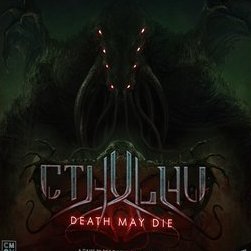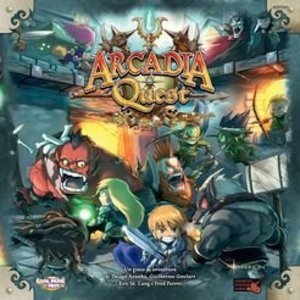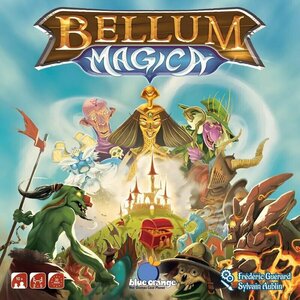
Cthulhu: Death may Die
Tabletop Game
In Cthulhu: Death May Die, inspired by the writings of H.P. Lovecraft, you and your fellow players...
Boardgames CMONgames LangGames DaviauGames CthulhuGames

Arcadia Quest
Tabletop Game
In Arcadia Quest, players lead guilds of intrepid heroes on an epic campaign to dethrone the vampire...
Boardgames Miniatures CMONgames 2014Games

Star Wars: Armada
Tabletop Game
Rebel and Imperial fleets fight for the fate of the galaxy in Star Wars: Armada, the two-player...

Dinosaur Island
Tabletop Game
In Dinosaur Island, players will have to collect DNA, research the DNA sequences of extinct dinosaur...
Boardgames JurassicParkTheBoardgame BooksintoGames WorkerPlacementGames

Wisdom Check (Dungeons and Dating #2)
Book
Julian’s boss is newly single, ridiculously hot, and looking his way. He’s so screwed. Cal...
Contemporary MM Romance

Dexterity Check (Dungeons and Dating #5)
Book
Eli’s sworn off irresponsible flirts, and Arjun’s one of the worst—aggravating, provoking, and...
Contemporary MM Romance Series

Bellum Magica
Tabletop Game
Each player represents an evil lord. Recruit creatures, ranging from simple goblins to terrifying...
Purple Phoenix Games (2266 KP) rated Stellar Leap in Tabletop Games
Apr 23, 2020
DISCLAIMER: We were provided a copy of this game for the purposes of this review. This is a retail copy of the game, so what you see in these photos is exactly what would be received in your box. We do not intend to cover every single rule included in the rulebook, but will describe the overall game flow and major rule set so that our readers may get a sense of how the game plays. For more in depth rules, you may purchase a copy online or from your FLGS. -T
Stellar Leap is, at its core, a worker placement game with elements of dice rolling, variable powers, and a modular ‘board’ sprinkled in. To setup, each player receives an individual player board and components, while the Galaxy is set up for use by all players. Players then add their home planet, as well as 1 population marker, to the Galaxy, and the game is ready to begin! Stellar Leap is played over a series of rounds in which players take turns performing any or all actions available to them.
To begin a turn, players first recover any Population markers that may have been exhausted on their last turn (more on that in a bit). Next, the player rolls the two dice, manipulating them with Special Dice Powers if desired, and resources are collected. The Galaxy is set up in columns, each column numbered 1-6, to which these dice rolls will correspond. If you have a Population marker on a planet in one of the columns that corresponds to your die roll (you have a Population in column 4 and you rolled a 4), you collect the resources provided by that planet. It is important to note that any player can receive resources from a die roll, even if it is not their turn!
The next phase of play involves three elements: Movement, High Command Actions, and Division Actions. There is no limit to the amount of Movement you can take on your turn, as long as you have resources available to perform that action. You may take two High Command Actions: Populate (add a new Population marker to a planet), Tax (collect any two resources), Discover (add planets/asteroids to the Galaxy), or Attack (fight an opponent located on the same planet as yourself). The same High Command Action could be performed twice on your turn, but you can only perform two per turn. The Division Actions can each be taken once per turn. Those actions are: Intelligence (complete a Mission), Mining (mine an asteroid for resources), or Labor (exhaust one of your populations on a planet to receive additional resources). Movement, High Command Actions, and Division Actions can be taken in any order on your turn – turns are not ‘set’ in a specific order and actions can be taken at your discretion. You also are not required to take every available action on your turn if you do not want to – your turns could be as long or as brief as you want them to be, depending on which actions you want to take.
At certain points throughout play, Events will be triggered. When an Event is triggered, draw the top Event card and resolve its effect. Some are resolved immediately, and some remain in play for the rest of the game. The game ends once six Events have been triggered. Players then tally up their Prestige points (earned by completing Missions, discovering planets, winning combats, and fulfilling their secret objectives), and the player with the highest Prestige is declared the winner!
So as you can see, there is quite a bit going on in Stellar Leap. Admittedly, it seemed pretty daunting to me as I first read through the rules. But in all actuality, the game flows pretty efficiently and calmly. How? Player Reference cards! I absolutely looooove a game that includes good references cards for player turns because it makes it so much easier to check instead of digging through the entire rulebook for an answer. The Player Reference cards included in this game are well-written, clear, and concise, and that truly helps the game flow smoothly even though there are many elements to every turn. Another thing that I love about Stellar Leap is that you have so many strategic options. Everyone has their own secret objectives for end-game scoring to complete, but you also have to decide which Missions you’d like to accomplish to earn points as well. And do you want to risk many combats, or would you rather live harmoniously with your opponents? When adding planets/asteroids to the Galaxy, you also have to strategize where you should put them – do you want them close to you for easy access? Or do you want to keep them as far away from opponents as necessary? The modular board makes this a different game every time you play, so you can’t just pick a blanket strategy for every play.
The only thing that gives me pause with this game are the rules regarding Movement. You pay certain resources to move, but it depends on the ‘threat level’ of the destination as well as its location in your Solar System or a neighboring Solar System. It just was a little tricky to keep track of how many of each resource I had to pay to move, when moving more than just one planet away. That aspect takes a little bit more concentration, but other than that, the game gave me no issues.
Speaking of no issues, let’s touch on components. The player boards are dual-layered and they are awesome. The text is clear, the organization is logical, and they are just of a great quality. The cards are nice and sturdy, the ‘meeples’ are cute and chunky, and the cardboard chits are good too. The space theme is definitely translated well in this game, and that adds to the immersion.
Overall, I would say Stellar Leap is stellar. (Ha, see what I did there?) The gameplay is engaging and the strategy is adaptable. Some of the rules seem a little tedious in some aspects, but for the most part, they are logical and easy to remember. Weird Giraffe Games is a publisher that has made a blip on our radar, and we are excited to see what other games they will put out in the future – we’ve been impressed so far! Purple Phoenix Games gives Stellar Leap an other-worldly 9 / 12.
Purple Phoenix Games (2266 KP) rated Hit the Silk! in Tabletop Games
Mar 9, 2021
Hit the Silk! is a semi-cooperative game about hidden information, strong and weak alliances, bluffing, and negotiation in the skies where the plane WILL go down. Players will be trading information with others in order to figure out which players they will unite with and which they will deceive to win the game. Not all players can win, and some players may not even survive the flight. WHO DO YOU TRUST?
DISCLAIMER: We were provided a prototype copy of this game for the purposes of this review. These are preview copy components, and I do not know for sure if the final components will be any different from these shown. Also, it is not my intention to detail every rule in the game, as there are just too many. For this preview I will be describing the Standard game mode. You are invited to download the rulebook, back the game through the Kickstarter campaign, or through any retailers stocking it after fulfillment. -T
To setup, place the Altimeter board on the table and set the needle to the correct altitude per number of players. The card organizer board is setup near the Altimeter with the Flannel cards on the Laundry space, the draw deck on the left space, and the discard pile between the two. Four cards are randomly placed face-down onto the Lockbox space on the Altimeter board, and six cards are dealt to the players. They will choose four to keep and discard the other two. Place all remaining components on the table. A first player is chosen and the game is setup to begin!
On a turn a player may do any or all of the following: Change a card, Take actions, Trade with another player. To change a card the current player will choose one card from their hand, either discarding face-up to the discard pile or to the Laundry if it is a Flannel card, and then drawing a number of cards pertaining to the altitude level on the Altimeter board (the higher the plane the less cards can be drawn). The player chooses one card to keep and discards the others.
Many cards will be action cards, so during a turn the active player can use as many action cards as they wish. To take an action the player simply notes any altitude adjustments printed on the card, adjusts the Altimeter needle by that much, then plays the card for its action. Some action cards allow players to Steal cards from another player (blocked by a Knife card), Spy another player’s hand, Handcuff two players together (or a player to a briefcase of money), use Key cards to unlock Handcuffs or to pilfer one card from the Lockbox on the Altimeter board, Poison another player (cured with the Antidote card), kick a weapon out of a player’s hand by using a Kung Fu card, or blatantly attacking a player by using both a Pistol and a Bullet card. Players will take one wound from the first bullet and will be permanently slain by taking another bullet wound.
The final action that can be taken on a turn is trading with another player. This is a risky action to take as players are not bound by their verbal agreements. Therefore, a player may offer to trade a Bullet and a Knife in exchange for a $10,000 and a Key card. However, neither player is REQUIRED to trade these exact items during the trade, and alliances weaken over trade disputes.
Intermittently throughout the game, as altitude drops, players are given the task to vote whether to keep flying or to hit the silk (which means to jump out of the plane with a parachute in hand)! Should players vote by majority to continue playing the game keeps going as before. If the players vote by majority to hit the silk!, then all players with parachutes reach the ground safely and pool together their money in hopes of reaching the goal amount determined at the start of the game. Those who jump without a parachute sadly perish, but those who are able to stay on the plane without being handcuffed to a jumping player may attempt the very difficult task of landing the plane (which involves the dice shown, but I will let you discover the method on your own).
Should the landing party have gathered enough money to pay the debt, those players win! If the player lands the plane correctly they win! If a player dies, well, they lose.
Components. Again, this is a prototype copy of the game, so components shown are probably going to look differently as the result of a successful Kickstarter campaign. That said, I want to first applaud Escape Plan Board Games for their usage of “eco-conscious production.” The component materials we received are certainly unlike any I have felt or played with in the past. They feel different, and I assume it is due to this new eco-friendly material they are using. I also want to point out the art style of Hit the Silk! It is fabulous and definitely gives off that jetset vibe. I love it! I do hope the dice will be getting an upgrade in the final version, as stickered dice are rarely in style. I have not seen or heard of any plans for upgrades or final components, but I hope a nice eco-friendly upgrade option exists for this game.
So here’s the rub. I truly like this game quite a bit. I do have issues with player elimination games, personally, because for whatever reason I am always the first to be targeted for elimination. While it’s funny at first, I despise having to be left out of the rest of the game. That said, I still very much enjoy this game. Yes, I don’t like being targeted, but I am able to take one for the team, and then ask players to try a different strategy the next playthrough. Being able to make loose alliances and just break trades by giving the other player two Flannels instead of the Parachute and Key is just fun times. I enjoy the ever-decreasing altitude of the plane that stresses players to get things done quickly without having the needle dip too far for comfort. I like that a lot.
I wish the dice were used more in the game (at least in Standard mode), as I love nice chunky dice, but I can look past this because the rest of the gameplay is so solid. I still have yet to figure out the best way to use the Handcuffs, but the weapons and Kung Fu are just so ridiculous and amazing simultaneously that I like using them as soon as I get them in hand. So if you, like me, have a hole in your collection for a game taking place in the skies featuring a gang of casino-chased hoodlums, then I urge you to take a look at Hit the Silk! Just know that if you handcuff yourself to me, you can bet on me making some very inappropriate comments.


